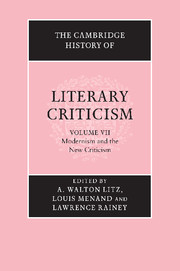4 - Virginia Woolf
from THE MODERNISTS
Published online by Cambridge University Press: 28 March 2008
Summary
For reasons soon to be enumerated, Virginia Woolf did not presume, nor openly aspire to take her place among the select company of writer-critics she admired. She would praise, but never mimic ‘the down right vigour of a Dryden, or Keats with his fine and natural bearing, his profound insight and sanity, or Flaubert and the tremendous power of his fanaticism, or Coleridge, above all, brewing in his head the whole of poetry and letting issue now and then one of those profound general statements which are caught up by the mind when hot with the friction of reading as if they were of the soul of the book itself’. Coleridge, indeed, was for her perhaps the greatest, certainly the purest of critics in his exemplary ‘in difference to, in his hatred of, “mere personality”’. Affections may be, as Coleridge affirmed, the ‘best part of humanity’, but the pure critic mounts ‘into an atmosphere where the substance of [human] desires has been shredded by infinite refinements and discriminations of all its grossness’ and the light of criticism ‘is concentrated and confined in one ray – in the art itself’.
By such standards, Woolf does not rate highly as a pure critic of literature. Her criticism, as she openly confessed, was of the grosser sort, adulterated by personal likings or aversions, alloyed by doubts and perplexities. It was, in short, so intent on tracking ‘the flight of the mind’ in all its unpredictable coursings that to capture the soul of the book was an outcome devoutly to be wished, but never confidently expected: ‘The critic may be able to abstract the essence and feast upon it undisturbed, but for the rest of us in every book there is something – sex, character, temperament – which, as in life, rouses affection or repulsion; and, as in life, sways and prejudices; and again, as in life, is hardly to be analysed by the reason.’
- Type
- Chapter
- Information
- The Cambridge History of Literary Criticism , pp. 122 - 137Publisher: Cambridge University PressPrint publication year: 2000
References
- 1
- Cited by



